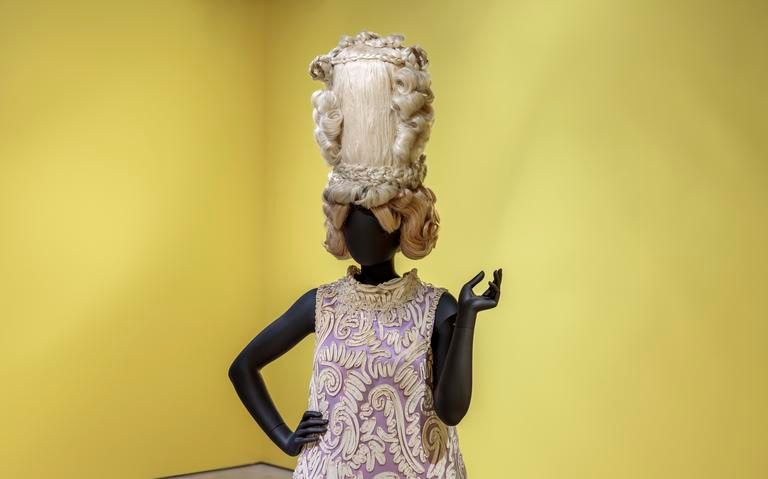How John Waters Exploded Velma Von Tussle’s ‘Hairspray’ Wig
And what it took to save the iconic film prop for a new exhibit—hint: lots of steam.
Douglas Retzler, special effects coordinator for the 1988 movie Hairspray, remembers thinking it “wouldn’t be right to blow up Debbie Harry’s head” during the production.
Yet the now-classic film, which would go on to inspire a 2007 adaptation, a Broadway musical, and a live television performance, called for Harry’s beehive hairdo to be explosively launched from her head, fly across the room, and land in a scorched heap amid appalled shrieks.
Fortunately, Retzler was able to find a solution that didn’t harm the “Blondie” singer and actress (whom John Waters reportedly calls “Deborah.”)
“I rigged up something called an air mortar, which is a large holding tank of air—I think it was a 20-gallon holding tank,” says Retzler. “It has a solenoid [an electromagnet] in it, and when you press a button, it dumps all the air out of the tank simultaneously,” causing Retzler’s wig to skyrocket.
During the filming of Hairspray, which took place in the summer of 1987, the air in the device was propelled through a one-inch hose that went under Harry’s dress and connected to a sort of hat upon which the wig was mounted.
“I did a whole series of tests on ways to make it fly—it was quite fun,” Retzler says. “I had about a dozen of these styrofoam-filled bouffant hairdos that I was filling with these model rocket engines, and rocketing them across a parking lot.”

Even after its punishing experiences on the set of the movie, the “exploding” wig used in Hairspray still exists today, and can be seen at the Academy Museum of Motion Pictures’s John Waters: Pope of Trash, the first comprehensive exhibition dedicated to Waters’ uniquely subversive, campy body of work. The exhibition, which opened on September 17, 2023, and runs until August 4, 2024, at the museum’s Los Angeles location, is accompanied by a retrospective screening series.
Jenny He and Dara Jaffe, co-curators of the exhibit, knew they wanted the famed exploding wig for the collection, but were unsure of its whereabouts or if it remained intact.
According to Jaffe, the two curators had been asking around about the wig since the inception of the project in 2020, checking with everyone from production designers to prop masters, along with “any hair person we were able to talk to.”
“We knew from the start that this was one of our wishlist fantasy items,” says Jaffe.
It wasn’t until one day when they were searching the Wesleyan University film archives that the two happened upon a nondescript box tucked away in a corner. They didn’t think much of the box at first, but when they looked inside, they were (figuratively) blown away.
In the box, labeled vaguely as “production object, costume component,” was the iconic wig—a towering beehive with a cavernous space for Retzler’s air mortar device. Perhaps not surprisingly, the used air mortar—which Retzler described as “Rube Goldberg jury-rigging”—was not included.
The wig memorably rockets off the head of Harry’s character, the cartoonishly racist, fatphobic villainess Velma Von Tussle, in one of the movie’s pivotal scenes, effectively thwarting Von Tussle’s sinister plan to sabotage the Miss Auto Show Pageant.

“We were just rummaging around, and so I happened to get to it first,” He says. “I uncovered the lid and I just started spontaneously screaming in this university archive.”
What happened next played like a scene from Hairspray itself, where fangirl screams are almost as ubiquitous as beehive hairdos.
“Dara came running over, and she looked into the box and she started screaming, too,” says He.
The bad news was that after years in storage, the wig needed quite a bit of restoration. But museum objects conservator Sophie Hunter was up to the task. Because the goal is long-term preservation and safety of the wig, no quick fixes or hair products were allowed. Yes, that meant no hairspray.
“As always, when we’re looking at an object, we want to preserve it for all time, not just for our show,” Jaffe said. “We want to make sure we are bolstering the safety of the object.”
Hunter said when it first got to her, the wig was “very frizzy” with the hair out of alignment and the curls loosened. But the most difficult challenge came from the wig’s decaying structure.
“It had a styrofoam plastic insert to make it so tall, but as is so common with plastics, the styrofoam was breaking down and crumbling,” says Hunter. “So, instead of looking like a really tall wig, it looked crunched and slumped over, because the styrofoam insert had totally deteriorated.”
Hunter, whose expertise is in restoring and conserving three-dimensional objects, didn’t have a great deal of experience in the “unique skill set” of wig work, so she consulted with Bernie Ardia, a 40-year veteran of theatrical wig design who worked on the wigs for Broadway’s Hairspray: The Musical.
“We were able to bring him on and work with him collaboratively to restore the wig,” says Hunter.

Hunter and Ardia first removed all pins from the original wig, closely documenting where each pin came from so they could be replaced precisely. At that point, the wig came apart into two pieces: a blond, human hair piece for the top portion, and a reddish, synthetic piece for the lower portion. Once the hair was removed, Hunter was able to take out the styrofoam insert and sculpt a new one from durable archival foam. The new insert will provide a stable structure from the inside that will last hundreds of years, Hunter said.
Then came Ardia’s area of expertise—styling the wig.
“Bernie came in and made a mold of the mannequin head that the wig was going to go on. He put the wig onto that mold,” says Hunter.
“Then he got to work on the hair. He reset the curls in curlers, and added some new stainless steel pins that wouldn’t corrode. Then he started to just restyle the hair and bring back the shape of the curls.”
Without the option of traditional styling products like hairspray, Ardia had to get creative, Hunter said. “He used steam to get the job done,” she said, “and it’s holding up.” The last step was to sew some of the curls in place using archival hair silk thread.
Retzler, who was delighted to hear about the wig’s new life as part of the exhibit, fondly recalls the days when it was his job to make wigs explode.
“I remember there was a mid-production party out on a pier where we were working,” he says. “I had all the styrofoam wigs left from when I was testing with the model rockets. So, we were having this party, and I was launching bouffant hairdos out into the Baltimore harbor. It really was a hoot.”











































Follow us on Twitter to get the latest on the world's hidden wonders.
Like us on Facebook to get the latest on the world's hidden wonders.
Follow us on Twitter Like us on Facebook